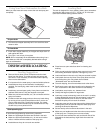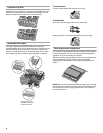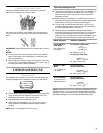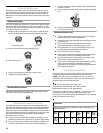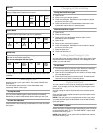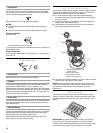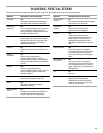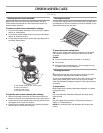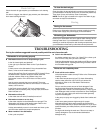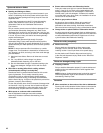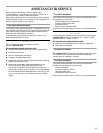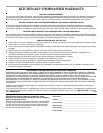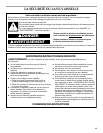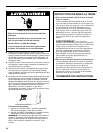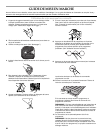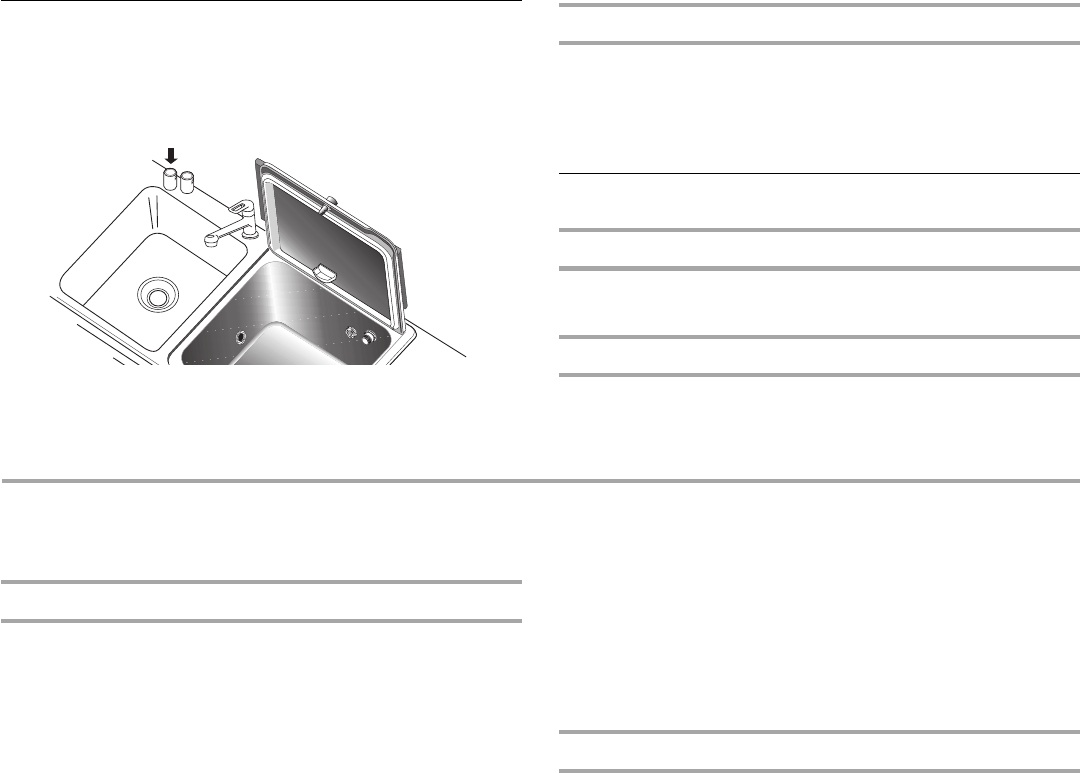
15
Drain Air Gap
Check the drain air gap anytime your dishwasher isn’t draining
well.
If a drain is clogged, the drain air gap protects your dishwasher
from water backing up into it.
To clean the drain air gap
Clean the drain air gap periodically to ensure proper drainage of
your dishwasher. Lift off the outer cover. Unscrew the plastic cap.
Then check for any soil buildup. Clean if necessary.
NOTE: The fill air gap is located to the right of the drain air gap
and does not require maintenance.
Storing
Storing for the summer
Protect your dishwasher during the summer months by turning
off the water supply and power supply to the dishwasher.
Winterizing your dishwasher
Protect your dishwasher and home against water damage due to
freezing water lines. If your dishwasher is left in a seasonal
dwelling or could be exposed to near freezing temperatures, have
your dishwasher winterized by authorized service personnel.
TROUBLESHOOTING
First try the solutions suggested here and possibly avoid the cost of a service call...
Dishwasher is not operating properly
■ Dishwasher does not run or stops during a cycle
Is the lid closed tightly and latched?
Is the right cycle selected? Refer to the “Cycle Selection
Charts.”
Is there power to the dishwasher? Has a household fuse
blown, or has a circuit breaker tripped?
Has the Ground Fault Circuit Interrupter (GFCI) tripped? Press
the Reset button. Indicator should be visible inside the
indicator window. Refer to the “Before Using Your
Dishwasher” section. If the GFCI does not reset, call for
service.
Has the motor stopped due to an overload? The motor
automatically resets itself within a few minutes. If it does not
restart, call for service.
Is the Drain stopper closed? If it is not closed properly,
selected cycle immediately ends, lid pops open, and Check
Drain indicator is lit.
■ Dishwasher will not fill
Is the water shut-off valve (if installed) turned on?
■ Dishwasher seems to run too long
Is the water supplied to the dishwasher hot enough? The
dishwasher runs longer while heating water. Refer to the
“Dishwasher Performance Tips” section.
A delay automatically occurs in some wash and rinse cycles
until the water reaches the proper temperature.
■ Water remains in the dishwasher
Is the cycle complete?
■ Odor in the dishwasher
Are dishes washed only every 2 or 3 days? Run a rinse cycle
once or twice a day until you have a full load.
Does the dishwasher have a new plastic smell? Run a vinegar
rinse as described in “Spotting and filming on dishes” later in
this Troubleshooting guide.
Dishes are not completely clean
■ Food soil left on the dishes
Is the dishwasher loaded correctly? Refer to the “Dishwasher
Loading” section.
Is the water temperature too low? For best dishwashing
results, water should be 120°F (49°C) as it enters the
dishwasher. Refer to the “Dishwasher Performance
Tips” section.
Did you use the correct amount of fresh detergent? Use
recommended dishwasher detergents only. Refer to the
“Detergent Use” section. Do not use less than 1 tsp (5 g) per
load. Detergent must be fresh to be effective. Store detergent
in a cool, dry area. Heavy soil and/or hard water generally
require extra detergent.
Is the pump or spray arm clogged by labels from bottles and
cans?
Is the home water pressure high enough for proper
dishwasher filling? Home water pressure should be 20 to
120 psi (138 to 828 kPa) for proper dishwasher fill. If you have
questions about your water pressure, call a licensed, qualified
plumber.
Are high suds slowing the wash arm? Do not use soap or
laundry detergents. Use recommended dishwasher
detergents only.



